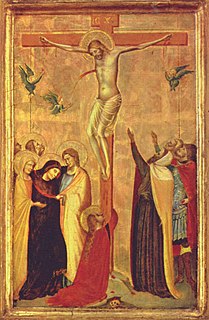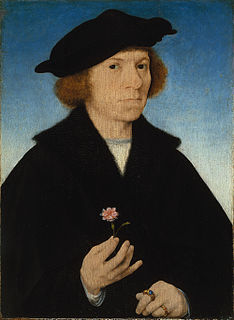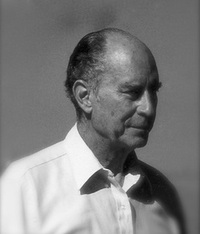Related Research Articles

Masaccio, born Tommaso di Ser Giovanni di Simone, was a Florentine artist who is regarded as the first great Italian painter of the Quattrocento period of the Italian Renaissance. According to Vasari, Masaccio was the best painter of his generation because of his skill at imitating nature, recreating lifelike figures and movements as well as a convincing sense of three-dimensionality. He employed nudes and foreshortenings in his figures. This had seldom been done before him.

Renaissance art is the painting, sculpture, and decorative arts of the period of European history known as the Renaissance, which emerged as a distinct style in Italy in about AD 1400, in parallel with developments which occurred in philosophy, literature, music, science, and technology. Renaissance art took as its foundation the art of Classical antiquity, perceived as the noblest of ancient traditions, but transformed that tradition by absorbing recent developments in the art of Northern Europe and by applying contemporary scientific knowledge. Along with Renaissance humanist philosophy, it spread throughout Europe, affecting both artists and their patrons with the development of new techniques and new artistic sensibilities. For art historians, Renaissance art marks the transition of Europe from the medieval period to the Early Modern age.

Adriaen Isenbrandt or Adriaen Ysenbrandt was a painter in Bruges, in the final years of Early Netherlandish painting, and the first of the Dutch and Flemish Renaissance painting of the Northern Renaissance. Documentary evidence suggests he was a significant and successful artist of his period, even though no specific works by his hand are clearly documented. Art historians have conjectured that he operated a large workshop specializing in religious subjects and devotional paintings, which were executed in a conservative style in the tradition of the Early Netherlandish painting of the previous century. By his time, the new booming economy of Antwerp had made this the centre of painting in the Low Countries, but the previous centre of Bruges retained considerable prestige.

Hugo van der Goes was one of the most significant and original Flemish painters of the late 15th century. Van der Goes was an important painter of altarpieces as well as portraits. He introduced important innovations in painting through his monumental style, use of a specific colour range and individualistic manner of portraiture. From 1483 onwards, the presence of his masterpiece, the Portinari Triptych, in Florence played a role in the development of realism and the use of colour in Italian Renaissance art.
Al Held was an American Abstract expressionist painter. He was particularly well known for his large scale Hard-edge paintings. As an artist, multiple stylistic changes occurred throughout his career, however, none of these occurred at the same time as any popular emerging style or acted against a particular art form. In the 1950s his style reflected the abstract expressionist tone and then transitioned to a geometric style in the 60s. During the 1980s there was a shift into painting that emphasized bright geometric space that's deepness reflected infinity. From 1963 to 1980 he was a professor of art at Yale University.

Ellsworth Kelly was an American painter, sculptor, and printmaker associated with hard-edge painting, Color Field painting and minimalism. His works demonstrate unassuming techniques emphasizing line, color and form, similar to the work of John McLaughlin and Kenneth Noland. Kelly often employed bright colors. He lived and worked in Spencertown, New York.

Antwerp Mannerism is the name given to the style of a group of largely anonymous painters active in the Southern Netherlands and principally in Antwerp in roughly the first three decades of the 16th century, a movement marking the tail end of Early Netherlandish painting, and an early phase within Dutch and Flemish Renaissance painting. The style bore no relation to Italian Mannerism, which it mostly predates by a few years, but the name suggests that it was a reaction to the "classic" style of the earlier Flemish painters, just as the Italian Mannerists were reacting to, or trying to go beyond, the classicism of High Renaissance art.

Bernardo Daddi was an early Italian Renaissance painter and the leading painter of Florence of his generation. He was one of the artists who contributed to the revolutionary art of the Renaissance, which broke away from the conventions of the preceding generation of Gothic artists, by creating compositions which aimed to achieve a more realistic representation of reality. He was particularly successful with his small-scale works and contributed to the development of the portable altarpiece, a format that subsequently gained great popularity.

Three Studies for Figures at the Base of a Crucifixion is a 1944 triptych painted by the Irish-born British artist Francis Bacon. The canvasses are based on the Eumenides—or Furies—of Aeschylus's Oresteia, and depict three writhing anthropomorphic creatures set against a flat burnt orange background. It was executed in oil paint and pastel on Sundeala fibre board and completed within two weeks. The triptych summarises themes explored in Bacon's previous work, including his examination of Picasso's biomorphs and his interpretations of the Crucifixion and the Greek Furies. Bacon did not realise his original intention to paint a large crucifixion scene and place the figures at the foot of the cross.

Joos van Cleve was a leading painter active in Antwerp from his arrival there around 1511 until his death in 1540 or 1541. Within Dutch and Flemish Renaissance painting, he combines the traditional techniques of Early Netherlandish painting with influences of more contemporary Renaissance painting styles.
Allan D'Arcangelo was an American artist and printmaker, best known for his paintings of highways and road signs that border on pop art and minimalism, precisionism and hard-edge painting, and also surrealism. His subject matter is distinctly American and evokes, at times, a cautious outlook on the future of this country.

Ronald "Ron" Davis is an American painter whose work is associated with geometric abstraction, abstract illusionism, lyrical abstraction, hard-edge painting, shaped canvas painting, color field painting, and 3D computer graphics. He is a veteran of nearly seventy solo exhibitions and hundreds of group exhibitions.

Triptych, May–June 1973 is a triptych completed in 1973 by the Irish-born artist Francis Bacon (1909–1992). The oil-on-canvas was painted in memory of Bacon's lover George Dyer, who committed suicide on the eve of the artist's retrospective at Paris's Grand Palais on 24 October 1971. The triptych is a portrait of the moments before Dyer's death from an overdose of pills in their hotel room. Bacon was haunted and preoccupied by Dyer's loss for the remaining years of his life and painted many works based on both the actual suicide and the events of its aftermath. He admitted to friends that he never fully recovered, describing the 1973 triptych as an exorcism of his feelings of loss and guilt.
Gregorio Prestopino (1907–1984) was an American artist. According to the art historian Irma B. Jaffe, he was "one of the major American painters who refused to reject the image, [and] has devoted his career to depicting the human condition with a warmth tempered only by honesty".
Sean Corcoran MIDI is an Irish visual artist noted for his stained glass, mosaics, wooden sculpture, and sand art.

The Irish-born artist Francis Bacon (1909–1992) painted 28 known triptychs between 1944 and 1986. He began to work in the format in the mid-1940s with a number of smaller scale formats before graduating in 1962 to large examples. He followed the larger style for 30 years, although he painted a number of smaller scale triptychs of friend's heads, and after the death of his former lover George Dyer in 1971, the three Black Triptychs.

Roberto Eduardo Biagio Borgatta y Ruiz (1921–2009), known professionally as Robert Edward Borgatta, was an American artist and foremost a nature painter whose style evolved from abstractions and later became more representational.

The Nativity is a devotional mid-1450s oil-on-wood panel painting by the Early Netherlandish painter Petrus Christus. It shows a nativity scene with grisaille archways and trompe-l'œil sculptured reliefs. Christus was influenced by the first generation of Netherlandish artists, especially Jan van Eyck and Rogier van der Weyden, and the panel is characteristic of the simplicity and naturalism of art of that period. Placing archways as a framing device is a typical van der Weyden device, and here likely borrowed from that artist's Altar of Saint John and Miraflores Altarpiece. Yet Christus adapts these painterly motifs to a uniquely mid-15th century sensibility, and the unusually large panel – perhaps painted as a central altarpiece panel for a triptych – is nuanced and visually complex. It shows his usual harmonious composition and employment of one-point-perspective, especially evident in the geometric forms of the shed's roof, and his bold use of color. It is one of Christus's most important works. Max Friedländer definitely attributed the panel to Christus in 1930, concluding that "in scope and importance, [it] is superior to all other known creations of this master."
Simon Dinnerstein is an American artist, best known for the painted work, The Fulbright Triptych (1971).
Leo Dee was an American artist and teacher. A native of Newark, New Jersey, he achieved first regional and then national prominence for his "incredibly detailed" and realistic silverpoint drawings which conveyed "the softest and most subtle transitions of tonal values."